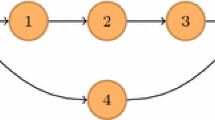Abstract
We consider the problem of schedulingn jobs without preemption on a single machine to maximize total profit, where profit is given by a nonincreasing, concave separable function of job starting times. A heuristic is given in which jobs are sequenced optimally relative to a specific linear approximation of the profit, function. This heuristic always obtains at least 2/3 of the optimal profit, and examples exist where the heuristic obtains only 2/3 of the optimal profit. A large class of alternative linearizations is considrred and shown to give arbitrarily bad results.
Similar content being viewed by others
References
K.R. Baker and L.E. Schrage, “Finding an optimal sequence by dynamic programming: An extension to precedence-related tasks,”Operations Research 26 (1978) 111–120.
D.C. Carroll, “Heuristic sequencing of single and multi-component orders”, Dissertation, Massachusetts Institute of Technology, (Cambridge, MA, 1965).
D.C. Carroll, private communication.
M.L. Fisher, “A dual algorithm for the one-machine scheduling problem,”Mathematical Programming 11 (1976) 229–251.
M.L. Fisher, “Worst-case analysis of heuristic algorithms,”Management Science 26 (1980) 1–17.
M.L. Fisher, “The Lagrangian relaxation method for solving integer programming problems,”Management Science 27 (1981) 1–18.
M.L. Fisher and A.M. Krieger, “Analysis of a linearization heuristic for single-machine scheduling to maximize profit”, Working Paper 81-06-01, Department of Decision Sciences, The Wharton School, University of Pennsylvania (Philadelphia, PA, 1981).
R.L. Graham, “Bounds on multiprocessing timing anomalies”,Siam Journal of Applied Mathematics 17 (1969) 416–428.
E.L. Lawler, “A ‘pseudopolynomial’ algorithm for sequencing jobs to minimize total tardiness”,Annals of Discrete Mathematica 1 (1977) 331–342.
J.K. Lenstra, A.H.G. Rinnooy Kan and P. Brucker, “Complexity of machine scheduling problems,”Annals of Discrete Mathematica 1 (1977) 343–362.
C.N. Potts, “Analysis of a heuristic for one machine sequencing with release dates and delivery times,”Operations Research 28 (1980) 1436–1441.
A.H.G. Rinnooy Kan, B.J. Lageweg and J.K. Lenstra, “Minizing total costs in one-machine scheduling,”Operations Research 23 (1975) 908–927.
W.E. Smith, “Various optimizers for single-stage production,”Naval Research Logistics Quarterly 3 (1956) 59–66.
Author information
Authors and Affiliations
Additional information
Work supported in part by NSF Grant ECS 82-05438 to the University of Pennsylvania and ONR Contract N00014-81-C-0302.
Rights and permissions
About this article
Cite this article
Fisher, M.L., Krieger, A.M. Analysis of a linearization heuristic for single-machine scheduling to maximize profit. Mathematical Programming 28, 218–225 (1984). https://doi.org/10.1007/BF02612362
Received:
Revised:
Issue Date:
DOI: https://doi.org/10.1007/BF02612362




